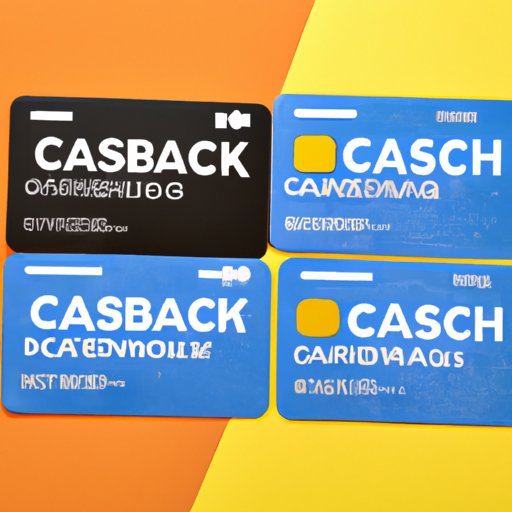
I. Introduction
If you’re looking for a credit card that rewards you for your spending habits, you’ll want to consider one with cash back options. Cash back rewards programs, offered by many credit card companies, provide a percentage of purchases as cash rewards. To make the most of these rewards, it’s essential to understand what they are, how they work, and how to maximize them. This article covers everything you need to know about cash back rewards on credit cards.
II. Maximizing Your Credit Card: How to Get Cash Back From Your Spending Habits
The first step in maximizing your cash back rewards is choosing the right credit card. Look for one with an attractive cashback offer tailored to your spending habits. For example, some cards offer higher cashback percentages on groceries or gas purchases. It’s essential to read and understand the card’s terms and conditions and any annual fees that may apply.
Next, you’ll want to manage your credit card spending habits to optimize cashback opportunities. One tip is to use the card for everyday purchases but ensure you pay off the entire balance each month to avoid any interest charges. Another strategy is to take advantage of sign-up bonuses by charging substantial expenses to the card during the initial months.
Example scenarios can help you understand how to maximize cashback. Suppose a cashback credit card offers 3% on groceries, 2% on travel expenses, and 1% on regular purchases. By using this card to pay for weekly groceries worth $150, one can earn $4.50 cashback. When that same card is used for a $400 travel booking, a $8 cashback reward is earned. Regular purchases worth $500 per month earn $5 cash back rewards. By the end of the year, you could earn hundreds of dollars in cashback rewards.
III. Exploring the Pros and Cons of Getting Cash Back on a Credit Card
Pros of using a credit card for cash back rewards include earning rewards for spending money that would have been spent anyway. Another advantage is the ability to redeem rewards for cash. Additionally, many cards offer bonuses for signing up that can provide a considerable discount or cashback benefit.
The main disadvantage when earning cashback on a credit card is the potential of higher interest rates and fees when balance payments are carried forward. Additionally, it’s essential to keep in mind potential fees associated with cashback transactions, such as transfer fees or redemption fees.
To avoid any of these drawbacks, it’s best to ensure that the cashback cards used match spending habits. It’s also vital to make timely payments to avoid interest and fees.
IV. Mixing and Matching Credit Card Rewards: Cash Back vs. Points vs. Miles
Credit cards offer different types of rewards, such as cash back, points, and miles. While cashback is self-explanatory, points and miles can be redeemed for various rewards, including flights or merchandise. It’s essential to compare these different reward systems when choosing a credit card.
The pros and cons of each reward system vary. For example, cashback is a simple and straightforward reward system, while points and miles can give you more extensive access to various travel and shopping-related perks.
The best reward system is entirely up to individual spending habits. If you don’t travel often, a cashback rewards program may be better suited for you. If you frequently travel, a rewards program with more extensive travel benefits may be a better fit.
V. The Cashback Credit Card Debate: Is It Worth It?
The value of cashback rewards is debatable. Those in favor of cashback rewards argue that rewards programs incentivize more mindful and beneficial spending habits. When using credit cards to make purchases they would make anyway, rewards programs provide a valuable and welcome bonus.
Those against cashback rewards programs argue that it’s easier to spend more money than you would have without cashback incentives. This overspending may result in higher credit card balances and interest payments.
Ultimately, whether or not cashback is worth it, depends on circumstances and individual spending habits. One way to ensure maximum benefit is by ensuring that credit card balance payments are made timely and that rewards are redeemed promptly.
VI. Redeeming Your Cash Back Rewards: Tips and Tricks
In most cases, cash back rewards programs offer a variety of redemption options, including check payment, credits to your account, or gift cards. For maximum benefit, it’s essential to understand your card’s redemption options and to choose the one that provides the most reward.
To make the most of your cash back rewards, it’s best to redeem them as soon as possible. This way, your rewards don’t expire or lose value. Additionally, you may want to consider combining the rewards earned from a cashback credit card with other rewards programs. For instance, redeeming cashback rewards as miles or points can provide access to travel and shopping-related perks.
Example scenarios can demonstrate how to redeem cashback rewards effectively. For instance, a $100 cashback reward can be used to prepay for an upcoming hotel booking, thus reducing overall expenses incurred during the trip.
VII. Conclusion
Cashback rewards programs can be an excellent way to benefit from spending habits. When used correctly, cashback rewards can provide a valuable boost to your finances. Equipped with the knowledge in this article, you are better informed to make the most of cashback rewards. So go ahead, find the right cashback credit card, and start reaping the benefits of cashback rewards today!
Call to action: Start maximizing your cash back rewards today. Choose the right credit card, optimize your spending habits, and earn cash rewards on your everyday purchases.




